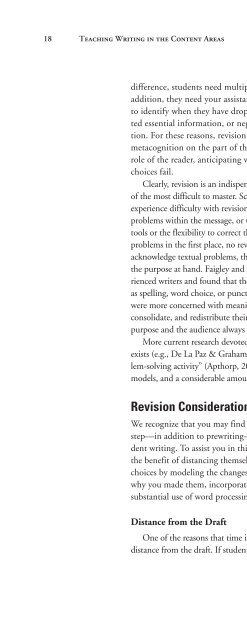How to Use It - ymerleksi - home
How to Use It - ymerleksi - home
How to Use It - ymerleksi - home
You also want an ePaper? Increase the reach of your titles
YUMPU automatically turns print PDFs into web optimized ePapers that Google loves.
18 Teaching Writing in the Content Areasdifference, students need multiple experiences <strong>to</strong> review their written texts. Inaddition, they need your assistance, or that of another knowledgeable person,<strong>to</strong> identify when they have dropped the thread of an intended message, omittedessential information, or neglected <strong>to</strong> completely reorganize the composition.For these reasons, revision is a stage that requires a substantial amount ofmetacognition on the part of the writer. Writers must place themselves in therole of the reader, anticipating when the text may confuse or when syntacticalchoices fail.Clearly, revision is an indispensable step in the writing process, but it is also oneof the most difficult <strong>to</strong> master. Schriver’s work (1992) reveals that writers typicallyexperience difficulty with revision for at least two reasons: (a) they do not recognizeproblems within the message, or (b) they notice problems but do not have the<strong>to</strong>ols or the flexibility <strong>to</strong> correct them. Schriver adds, “If writers fail <strong>to</strong> notice textproblems in the first place, no revision occurs” (p. 181). Even when writersacknowledge textual problems, they must recognize those that are consequential <strong>to</strong>the purpose at hand. Faigley and Witte (1981) and Yagelski (1995) studied inexperiencedwriters and found that their revisions tended <strong>to</strong>ward surface changes suchas spelling, word choice, or punctuation. Experienced writers, on the other hand,were more concerned with meaning. Their rethinking caused them <strong>to</strong> add, delete,consolidate, and redistribute their words, improving their writing by keeping thepurpose and the audience always in mind.More current research devoted <strong>to</strong> revision indicates that this discrepancy stillexists (e.g., De La Paz & Graham, 2002; Zhang, 2001). Engaging in this “problem-solvingactivity” (Apthorp, 2001) requires sufficient time, access <strong>to</strong> explicitmodels, and a considerable amount of thinking aloud.Revision Considerations and ActivitiesWe recognize that you may find setting aside time for revision difficult, but thisstep—in addition <strong>to</strong> prewriting—has the potential <strong>to</strong> significantly improve studentwriting. To assist you in this process, we suggest that you help students seethe benefit of distancing themselves from their written drafts, discuss revisionchoices by modeling the changes you make <strong>to</strong> your own writing and explainingwhy you made them, incorporate peer review in<strong>to</strong> your classrooms, and makesubstantial use of word processing programs.One of the reasons that time is so essential <strong>to</strong> the writing process is the need fordistance from the draft. If students do not have opportunities <strong>to</strong> detach themselves
















